
The setaceous Hebrew character is a moth of the family Noctuidae. The species was first described by Carl Linnaeus in his 1758 10th edition of Systema Naturae. It is found in the Palearctic realm. It is a common species throughout Europe and North Asia and Central Asia, South Asia, China, Japan and Korea. It is also found in North America, from coast to coast across Canada and the northern United States to western Alaska. It occurs in the Rocky Mountains from Montana to southern Arizona and New Mexico. In the east, it ranges from Maine to North Carolina. It has recently been recorded in Tennessee.

Dryocampa rubicunda, the rosy maple moth, is a small North American moth in the family Saturniidae, also known as the great silk moths. It was first described by Johan Christian Fabricius in 1793. The species is known for its wooly body and pink and yellow coloration, which varies from cream or white to bright pink or yellow. Males have bushier antennae than females, which allow them to sense female pheromones for mating.

Eumorpha pandorus, the Pandora sphinx moth or Pandorus sphinx moth, is a North American moth in the family Sphingidae. The species was first described by Jacob Hübner in 1821.

Hemaris thysbe, the hummingbird clearwing, is a moth of the family Sphingidae (hawkmoths). Coloration varies between individuals, but typically the moth is olive green and burgundy on its back, and white or yellow and burgundy on the underside. Its wings are transparent with a reddish-brown border. It has light-colored legs, which combined with the lack of striping on the underside is diagnostic. Beating its wings rapidly, H. thysbe hovers to collect nectar from a variety of flowers. The combination of its appearance and its behavior commonly leads to it being confused with a hummingbird or bumblebee.
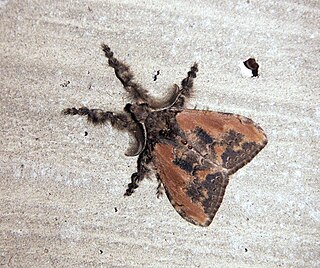
Olene mendosa, the brown tussock moth or hairy tussock moth, is a moth of the family Erebidae. The species was first described by Jacob Hübner in 1823. It is found in India, Bangladesh, Sri Lanka, Indonesia, Taiwan, Thailand and Australia.

Zygaena is a genus of moths in the family Zygaenidae. These brightly coloured, day-flying moths are native to the West Palearctic.

Lomographa bimaculata, the white-pinion spotted, is a species of geometer moth. It belongs to the large geometer moth subfamily Ennominae, and therein to the tribe Baptini. It is – under its junior synonym – the type species of its genus Lomographa. It is also the type species of Bapta, a junior objective synonym of Lomographa and the namesake of the Baptini. The species was first described by Johan Christian Fabricius ion 1775.

Orthonama obstipata, the gem, is a moth of the family Geometridae. The species was first described by Johan Christian Fabricius in 1794. It is a cosmopolitan species. In continental Europe though in the northeast, its range does not significantly extend beyond the Baltic region and it is absent from northern Russia. This well-flying species is prone to vagrancy and able to cross considerable distances of open sea; it can thus be regularly found on the British Isles and even on Iceland.

The Azelinini are a tribe of geometer moths in the subfamily Ennominae, with many species in the Southern Hemisphere, particularly in South America. Several species are found in North America as well. These stocky geometer moths seem to be closely related to other robust tribes, such as the Campaeini, Ennomini, Lithinini and Nacophorini – all of which might warrant to be subsumed in the Ennomini – the genus Odontopera, and perhaps the Caberini and Colotoini. The tribe was first described by William Trowbridge Merrifield Forbes in 1948.

Speiredonia is a genus of moths in the family Erebidae. It was first described by Jacob Hübner in 1823.

Spirama is a genus of moths in the family Erebidae first described by Achille Guenée in 1852.
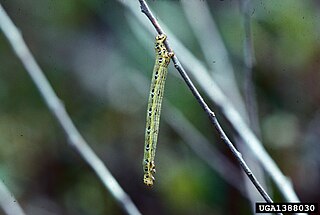
Cingilia is a monotypic moth genus in the family Geometridae erected by Francis Walker in 1862. Its only species, Cingilia catenaria, the chain-dotted geometer, chain dot geometer, chainspotted geometer or chain-spotted geometer, was first described by Dru Drury in 1773. It is found in North America from Nova Scotia south to Maryland and west to Kansas and Alberta.
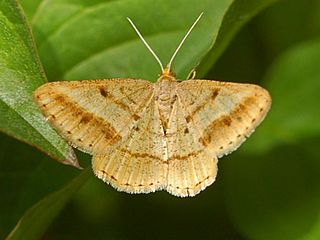
Isturgia is a genus of moths in the family Geometridae described by Jacob Hübner in 1823.

Spirama helicina is a moth of the family Erebidae first described by Jacob Hübner in 1824. In older texts, the species was classified as morph of Spirama retorta.

Euparthenos is a monotypic moth genus in the family Erebidae erected by Augustus Radcliffe Grote in 1876. Its only species, Euparthenos nubilis, the locust underwing, was first described by Jacob Hübner in 1823. The adults resemble some of the underwing moths of genus Catocala, which are fairly close relatives, in color, pattern, and the habit of resting on tree trunks. But E. nubilis can usually be immediately recognized by the four concentric black bands per hindwing, as opposed to one or two in Catocala. Color morphs of E. nubilis with altered pattern are known, however, and these may be hard to recognize without detailed examination.
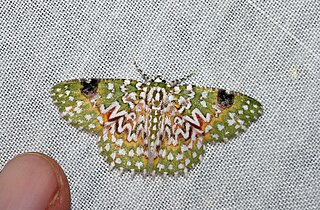
Eucyclodes gavissima, the Oriental orange banded green geometer moth, is a species of moth of the family Geometridae described by Francis Walker in 1861. It is found in the Indian subregion, Sri Lanka, Bhutan, western China, Taiwan, Vietnam, Sumatra and Borneo.

Ennomos subsignaria, the elm spanworm moth, is a moth of the family Geometridae. The species was first described by Jacob Hübner in 1823. It is found in North America from Texas (south) to Alberta (northwest) and east to the Atlantic coast. It is recorded infrequently in Great Britain through accidental importation in asparagus.

Smyrna blomfildia, the Blomfild's beauty, is a species of butterfly in the family Nymphalidae.
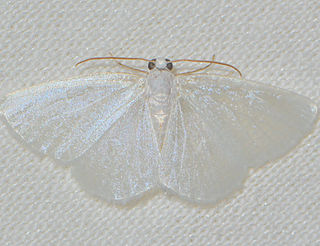
Lomographa vestaliata, the white spring moth, is a moth in the family Geometridae. The species was first described by Achille Guenée in 1857. Adults are diurnal and on wing in spring.
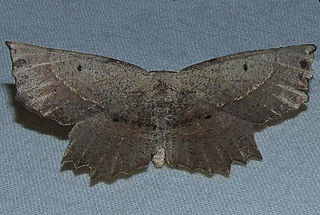
Euchlaena obtusaria, the obtuse euchlaena moth, is a moth of the family Geometridae. The species was first described by Jacob Hübner in 1813. It is found in North America, where it has been recorded from Alberta east to Nova Scotia, south to Florida and Texas. The habitat consists of mixed wood forests.




















